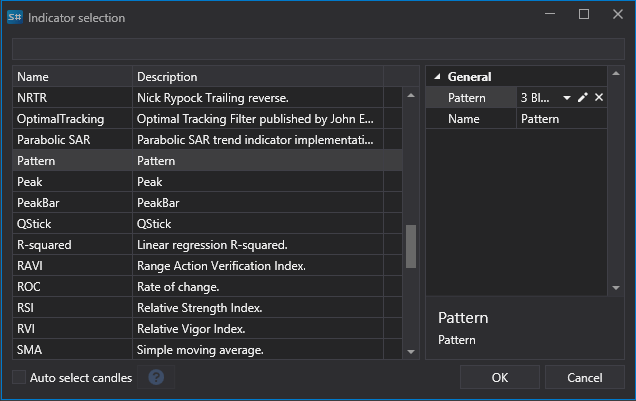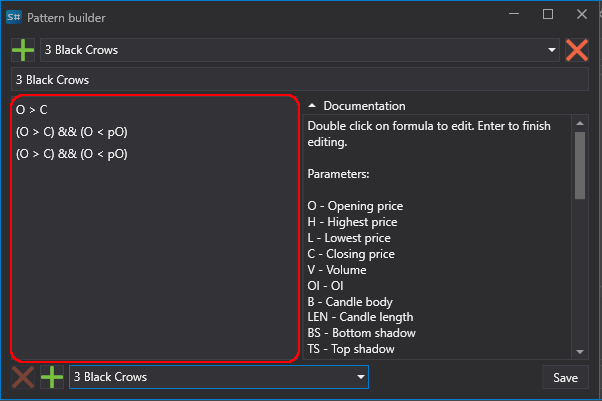Patterns
Pattern (from English: pattern — model, sample) — in technical analysis, refers to stable recurring combinations of price data, volume, or indicators. Pattern analysis is based on one of the axioms of technical analysis: "history repeats itself" — it is believed that recurring data combinations lead to similar results.
Patterns are also called "templates" or "figures" of technical analysis.
Patterns are conventionally divided into:
- Indeterminate (can lead to both continuation and change of the current trend).
- Continuation patterns of the current trend.
- Patterns of existing trend reversal.
Using Patterns
In Designer
Designer has built-in preset candlestick patterns that can be used in your trading strategy. Patterns are called through the indicator cube with the subsequent selection of the corresponding value. The pattern itself is selected from the drop-down list in the window on the right.

It is also possible to edit existing and add your own custom patterns. To do this, you need to click on the button  after which the pattern editing window will be shown.
after which the pattern editing window will be shown.

To create your own pattern, click the  button at the top of the window. Clicking the
button at the top of the window. Clicking the  button deletes the pattern.
button deletes the pattern.
In Terminal
In Terminal, patterns are added to the chart like any other indicator. To do this, simply right-click on the chart and select the appropriate indicator from the list of available ones.
In StockSharp API
When using S# (or when creating strategies from code in Designer), working with patterns is done as with any other indicator. Example of use:
// Creating a pattern indicator
var patternIndicator = new CandlePatternIndicator
{
// Setting the desired pattern
Pattern = new ExpressionCandlePattern("My pattern", new[]
{
new CandleExpressionCondition("C > O"), // Current candle is rising
new CandleExpressionCondition("pC < pO") // Previous candle is falling
})
};
// Adding the indicator to the collection
Indicators.Add(patternIndicator);
// Processing a candle
var result = patternIndicator.Process(candle);
// Checking the result
if (result.GetValue<bool>())
{
// Pattern detected, perform necessary actions
}
Pattern Description Format
When editing a pattern, each line represents a separate candle. The topmost line is the current candle, accordingly, the second line is one candle back, the third and subsequent lines are minus 2 and more candles.
The editor uses the following parameters:
- O - opening price,
- H - high,
- L - low,
- C - closing price,
- V - volume,
- OI - open interest,
- B - candle body,
- LEN - length of the candle (from high to low),
- BS - lower shadow of the candle,
- TS - upper shadow of the candle.
With parameters, it is possible to use the following indices (references) to the desired values. For example, for the closing price:
- C: closing price of the current candle,
- C1: closing price of the 1st candle after the current one,
- C2: closing price of the 2nd candle after the current one,
- pC: closing price of the previous candle,
- pC1: closing price of the candle before the previous one, All references must be within the range of the current pattern. For example, the range of the 3 Black Crows pattern consists of the current and two previous candles, so referring to the third previous candle is not allowed.
For additional verification of parameters in correlation, the expression && is used, representing a logical AND.
When describing a pattern, it is also possible to use the following functions: abs, acos, asin, atan, ceiling, cos, exp, floor, log, log10, max, min, pow, round, sign, sin, sqrt, tan, truncate. More about using functions is explained in the description of the formula cube.
When using ExpressionCandlePattern in code, formulas are created by the same rules as described above and use the same variables.
Standard Patterns
For quick creation of patterns based on existing ones, you can use the section at the bottom of the pattern editor window. Clicking the  button at the bottom of the window adds the logic of the pattern selected from the drop-down list opposite to the editing window. The
button at the bottom of the window adds the logic of the pattern selected from the drop-down list opposite to the editing window. The  button at the bottom of the window deletes the selected line in the editing window.
button at the bottom of the window deletes the selected line in the editing window.